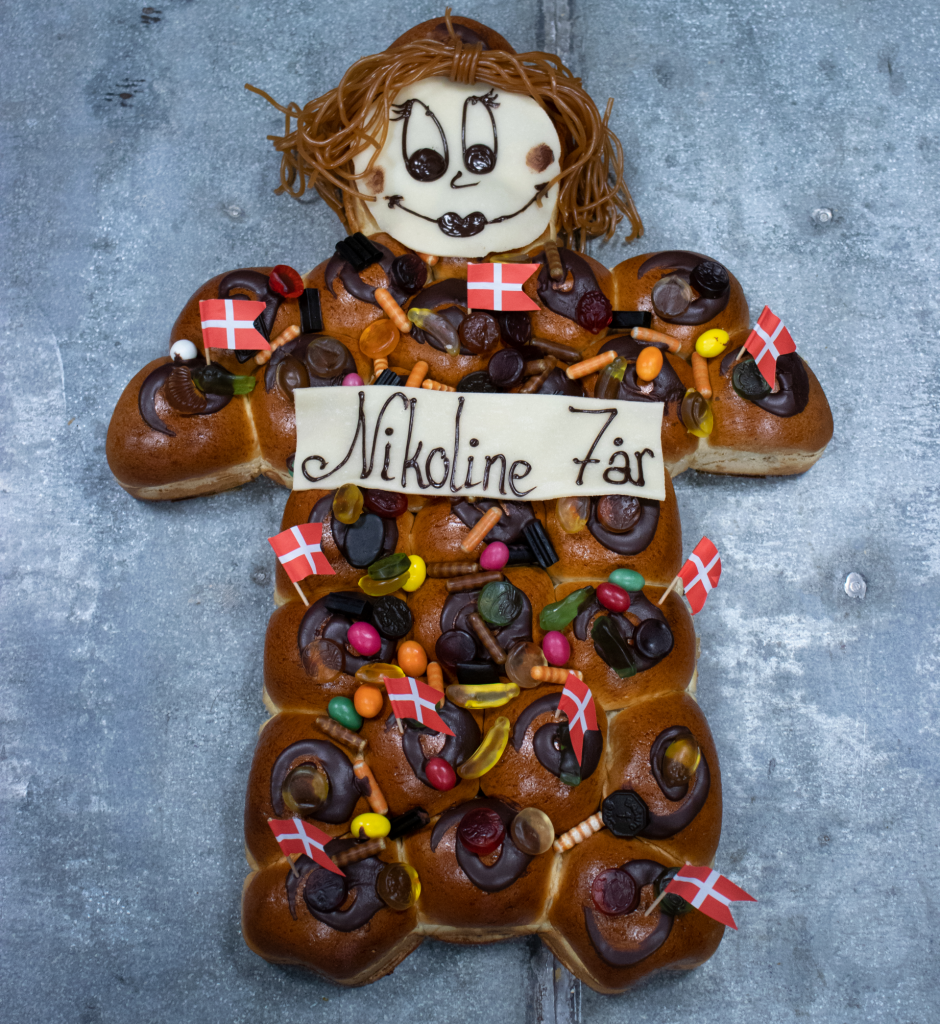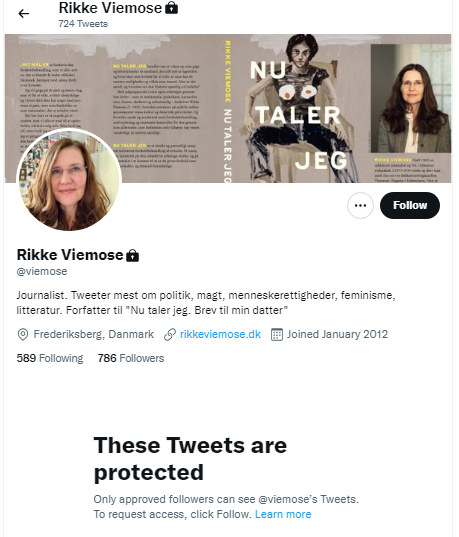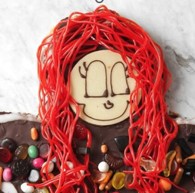Yesterday’s post was about the stupid prizes we’re winning for the stupid games we’re playing with language.
That theme continues today.
We’re going to start with a recent decision of the Danish bakery chain Lagkagehuset (the name translates to “The Layer Cake House”) to replace two of their popular cakes, the so-called kagemand (“cake man”) and kagekone (“cake wife”) with the gender neutral kageperson (“cake person”—but you probably figured that out on your own).
These are cakes decorated with candies. Here’s what the cake man and cake wife look like:

They’re most often served at kids’ birthday parties, but they also sometimes show up in the workplace. (It’s a Danish tradition for people celebrating birthdays to serve cake or other treats to their colleagues: yes, Americans, that’s correct: on your birthday, you bring the sugary bling.)
So what’s it all about?
The pastry is renamed to make the cake more diverse and inclusive, explains Malin Gardeström, who is responsible for brand marketing and external communication at Lagkagehuset…
“For us, it is important that we reflect the present and embrace the diversity that is in society and also provide opportunities for those who do not normally feel reflected in the binary gender representation,” she says.
It’s an opportunity for people who don’t feel reflected in the binary gender representation of cakes, she means.
Because having to order a cake that doesn’t conform to your own individual ideas of your own particular sex or gender can truly be a soul-crushing experience.
We can’t expect gender fluid, non-binary, and other fancy people to simply eschew buying people-shaped cakes at Lagkagehuset. They have to be able to buy them, and they have to be granted the spiritually affirming experience of sharing and enjoying a cake that conforms to their own sexuality (or the sexuality of the person for whom the cake was bought).
And please note: they’re replacing a choice of two cakes with a single offering. That is, they’re making things more diverse and inclusive by reducing your options.
All that said, there’s actually much less going on here than meets the eye.
In the past you would go to Lagkagehuset and order your cake. You’d begin by ordering a cake wife or a cake man, which established the defaults: cake man gets legs and short hair and short eyelashes, cake wife gets skirt bottom and long hair and long eyelashes. Those are the only differences. Neither cake has hands or feet—or sexual organs. The cake wife doesn’t even have anything suggestive of breasts.
In fact, the body of cake wife looks like a slice of toast and the body of cake man looks like the symbol for Pi….

But it was all negotiable anyway. You could ask for a short-haired cake wife or a long-haired cake man. You could ask for your cake to be lashless. You could request a mustache, a beard—probably even piercings or tattoos, I’d guess. I’d be surprised if the bakers of Lagekagehuset hadn’t had some pretty kinky requests for other custom bits over the years. (If you replace “kage” with “tisse,” which is the verb for peeing, you get tissemand and tissekone, which are the precise Danish “baby talk” words for penis and vagina. Little boys have a pee-man and little girls have a pee-wife. I suppose that’s an important contextual note.)
The new way, you’ll order a cake person, and the skirt-versus-legs thing would just be one of the many options for you to choose. So really: no difference at all.
The logic of the old model went like this: choose cake man or wife (defaults included). Customize.
The logic of the new model will go like this: choose cake person (no defaults). Customize (including the former defaults, which are now mere options).
So why bother?
“Because diversity is super important. We’re assuming too much if we only let the customer choose between a cake man and cake wife.”
Yes, it is better they should have no choice at all until they get to make all their choices.
The thing is, cakes have no sense of self—no “identities.” If you’re a dude who identifies as a chick, order the damn cake wife. And vice-versa. We don’t do gender reassignment surgeries on fucking cakes.
When asked if the change had any meaning for customers, Gardström answers:
I don’t think it means something to everyone. If you’re happy to order a cake man, then that’s super nice. But if you’re a person who wants something different, it doesn’t take anything away from those who want the completely classic.
Vomitous word sputum. As meaningless in Danish as it is in English.
“If you want something different?” From what? There’s no indication there’ll be any “bottom” choices beyond legs or skirts. Hair can obviously be long or short. And eyelashes—Jesus Christ, woman, you realize we’re talking about cakes, right?
Did anyone ask for this arrangement of options?
“We haven’t received any inquiries,” she answers, “but it’s a celebration cake that ought to look like the person being celebrated, and in that way we’d like to meet a need.”
A need. A need that no one had even articulated. A need to look at a fucking cake and see oneself in all one’s sexual and gender complexity.
I’m sure little Nikoline’s first thought upon receiving this cake on her 7th birthday was, “Oh my god, it looks just like me, right down to my wild gender fluidity!”

As Denmark’s largest bakery chain, Gardeström reminds us, Lagkagehuset has a special responsibility:
We also help to set the agenda. That’s why it’s also important to keep up with the times. There are lots of emotions in baked goods, because we’re part of the holidays that families and friends have together.
They “set the agenda” by “keeping up.” With all the emotions. In ways that no one had asked for.
The reporter didn’t bother asking the obvious follow-up: what agenda? What the hell are you talking about? You’re a bakery.
Asked if anyone’s accused them of having gone too woke, she replies:
To them I want to ask if diversity is woke? We do not remove anything, we just add something to make room for more wishes.
You did no such thing. You changed the order of operations.
Enough about cake people: believe it or not, there’s a whole new circus in Denmark’s retail environment.
“Stupid and untimely”: Føtex removes T-shirts from stores
Christina Toustrup Eriksen, Berlingske.dk, May 8
Føtex is one of the major Danish grocery chains. Like most modern grocery chains, their stores offer clothing, dry goods, hardware, electronics, toys, and other consumer goods alongside the groceries.
Barely has the dust settled from Lagkagehuset’s controversial decision to rename “cake man” and “cake wife” to “cake person” before a new discussion emerges from the depths of political correctness.
Now it seems that Føtex is removing a number of statement T-shirts from their stores because they have a “stupid and untimely message.”
“Seen in Føtex today,” tweets journalist and author Rikke Viemose with a picture of a T-shirt that says:
“Dad’s house. Dad’s rules.”
Obscene, right? Should I have put a trigger warning on this post?
It has once again set in the discussion of where the line of political correctness should be drawn. And after the post has been on social media for a good 24 hours, Føtex itself has also made its mark on the debate with the short message:
“Stupid and untimely message. We are removing them,” writes Jacob Krogsgaard Nielsen, who is a communications employee at the grocery group SallingGroup, which owns Føtex.
If the comments weren’t already rolling in at the time of posting, they sure are now. It’s seen as provocative that Føtex reacted so promptly by removing the shirts from the shelves.
Among others, Rasmus Jarlov, Member of Parliament for the Conservatives, criticizes Føtex for the decision.
“Føtex, which is otherwise the epitome of the ordinary Dane, removes a T-shirt because it has the text: Dad’s rules. The microscopic segment of insecure people who are offended by gender roles has far too much influence,” Jarlov wrote (in a tweet).
Well, yeah.
First of all, what is “stupid and untimely” about the slogan “Dad’s house, dad’s rules?”
Let me rephrase: what is so stupid and so untimely about it that it had to be pulled from the stores?
Sincere question. Fair enough that Rikke Viemose didn’t like it: she has two children with the execrable David Trads, so her aversion to dad-positive messages is understandable. But as T-shirt slogans go, it’s actually kind of benign, isn’t it? Think how uptight you’d have to be to find it offensive enough to tweet about it, much less pull it from your shelves.
Is Føtex handing product veto rights out to deranged leftist journalists? Because that doesn’t strike me as a very good business plan. Precedents matter. People notice things.
Another question: Jarlov appears to be assuming Viemose’s objection was grounded in opposition to the gender roles implied by the T-shirt. But was it? There’s nothing in the article to suggest that was actually the basis of her repugnance. Indeed, the article only informs us that she posted a pic of the shirt along with a text saying, “Look what I saw at Føtex.” So I wanted more context—but then I ran into this:

Fewer than 800 followers on Twitter—but I guess it only took one to get the job done.
Has her account always been “protected” or did she shut it down because “Dad’s rules” partisans were coming at her hard and fast?
I’ll never know, because I’ll never care enough to work any harder to find out.
Which brings me to my third and final question:
Who are these brainless, humorless fucks who’ve taken over the world?
On the one hand, Lagkagehuset trumpets what amounts to a procedural change in the way you order a particular kind of cake as a massive blow for gender rights, despite no one ever having objected to the old way. Message: it’s about diversity and inclusion and having cakes that look like your inner sexuality!
And on the other, Føtex gets a single complaint about a T-shirt slogan from a single activist and instantly removes the shirt from the shelves on all 107 of their stores. Message: those shirts were stupid and untimely, just like the customers who bought them!
The only positive thing I get from these stories is the fact that they’re stories. They’re stories because Danes still seem to have enough sense to realize it’s all idiocy.
Hold that line, my fellow Danes, because I assure you: we ain’t seen nothin’ yet.

“We also help to set the agenda. That’s why it’s also important to keep up with the times. There are lots of emotions in baked goods, because we’re part of the holidays that families and friends have together.”
My God, the sheer megalomaniacally entitled idiocy on display is simply staggering. We have somehow managed to raise several generations of Look-At-Me! people completely obsessed with making sure everyone around them is made aware of how with-it they are.
Except that is not quite correct. Not everyone is a Look-at-me! person.
Those that aren’t are often conflict-averse cowards, apparently. And they congregate in board rooms and management positions over the entire western world, while the Look-at-Me! contingent gathers on Twitter, Facebook, media and HR departments.
Diversity is important so we are reducing your options. Look at me!
We also help to set an agenda. Look at me!
To borrow a line from Mark Steyn, I used to worry that we would have a civil war; now I worry that we won’t
A great line from Steyn that I hadn’t heard before! A funny thing about Lagkagehuset’s lady’s riff that I hadn’t thought of originally is that by her logic, pretty much everything is loaded with emotions and therefore needs to get involved in setting the agenda and keeping up with the times (and that’s super nice!). Think of all the things we share with families and friends on holidays and special occasions: wine, beer, potatoes, meat, water, juice, soda, vegetables, candles, candy, nuts, chips — and that’s just what’s on the table! I also realize I completely omitted a very salient point, which is that the whole switch from sexed cakes to a single neutered starting option was apparently necessary to accommodate Lagkagehuset’s (as yet unreleased) new app. So really this is just a case of a technical requirement forcing a change in business logic (instead of vice-versa), and the communications team trying to make it into some kind of big win. Insanity.
But…if a woman-born-as-a-male-phenotype wants a lady cake to reflect hier* inner reality of being a woman… and there are no lady cakes, just all the same (let’s call them) Mao cakes, then, then, then…WHERE ARE ALL THE LADY CAKES?! I imagine the outcry. “I wasn’t born NEUTRAL! Where’s my lady cake to reflect my inner reality! None of these PERSON CAKES has a VAGI–oh wait, neither do I, BOOOOOOOOOBS! There are no boobs! These all look like MEN! We’ve gone too far!”
Well… I guess it’s true what I’ve heard my whole life, It’s a man’s world. (Insert picture of Lia Thomas finishing first. Phrase used with deliberate innuendo.)
*His+her=heis. I might have just invented useful pronouns: m2f: hesh, hier; f2m: sheh, heis; it’s confusing until you get the hang of it (like learning Polish).
That gets to the heart of the issue: if a bakery really wanted to get into the business of reflecting inner identities in their confectionary products, it could just call it a “you cake” and then ask every customer: “and what should your ‘you cake’ look like?” Wouldn’t that be more sensible, and easier, than the route Lagkagehuset has taken?